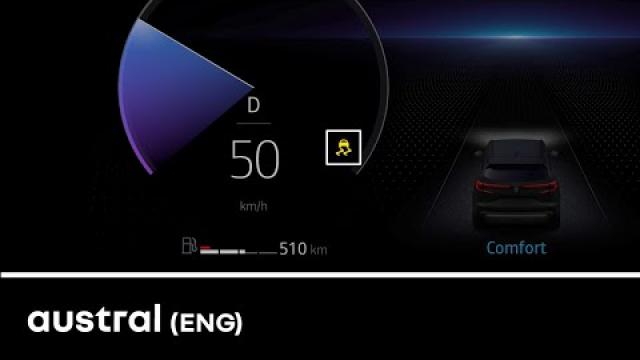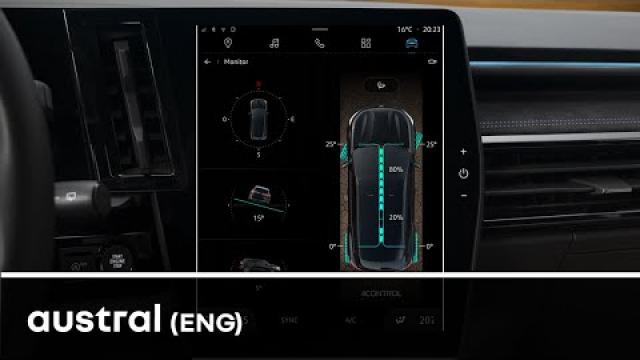Back to the list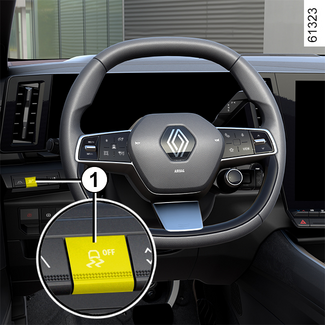
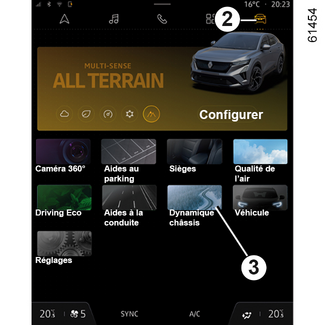

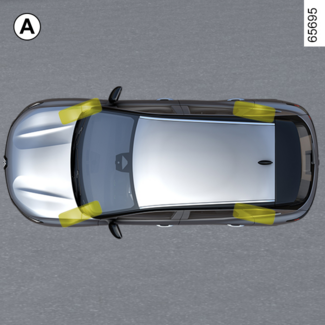

 requires you to stop as soon as traffic conditions allow. Call an approved dealer.
requires you to stop as soon as traffic conditions allow. Call an approved dealer.
Driver correction devices and aids
Driver correction devices and aids
Depending on the vehicle, they may include:
- the anti-lock braking system (ABS);
- the electronic stability control (ESC) with understeer control and traction control;
- emergency brake assist;
- driver assistance with a trailer;
- hill start assistance;
- the Hill Descent Control (HDC);
- the rear wheel steering;
- multi-collision braking;
- regenerative braking system.
WARNING
These functions are an additional aid in the event of critical driving conditions,
enabling the vehicle behaviour to be adapted to suit the driving conditions.
These functions do not take the place of the driver. They do not increase the vehicle's limits and should not encourage you to drive more
quickly. Therefore, they can under no circumstances replace the vigilance or responsibility
of the driver when manoeuvring the vehicle (the driver must always be ready for sudden
incidents which may occur when driving).
Anti-lock braking system (ABS)
During intensive braking, the ABS prevents the wheels from locking, allowing the stopping distance to be managed and
keeping control of the vehicle.
Under these circumstances, the vehicle can be steered to avoid an obstacle whilst
braking. In addition, this system can increase stopping distances, particularly on
roads with low surface grip (wet ground etc.).
You will feel a pulsation through the brake pedal each time the system is activated.
The front passengerABS does not in any way improve the vehicle's physical performance relating to the road
surface and road-holding. It is still essential to follow the rules of good driving practice (such as driving at a safe distance
from the vehicle in front etc.).
Tip
In an emergency, apply firm and continuous pressure to the brake pedal. There is no need to pump it repeatedly. The front passengerABS will modulate the force applied in the braking system.
Operating faults:
and
light up on the instrument panel, accompanied by the "Check ABS", "Check braking system" and "Check ESC" messages to indicate that theABS, theESC and Emergency Braking Assist are deactivated. Braking is still provided;
,
,
and
light up on the instrument panel, accompanied by the "Braking system fault" message to indicate a fault in the braking system.
In both cases, please consult an Authorised Dealer.
WARNING
Your braking systems are partially operational. However, it is dangerous to brake suddenly and it is essential to stop immediately, as soon as traffic conditions allow. Call
an approved Dealer.
Electronic stability control (ESC) with understeer control and traction control
Electronic stability program ESC
This system helps you to keep control of the vehicle in critical driving conditions
(avoiding an obstacle, loss of grip on a bend, etc.).
Operating principle
A sensor in the steering wheel detects the direction selected by the driver.
Other sensors throughout the vehicle measure the actual direction.
The system compares driver input to the actual trajectory of the vehicle and corrects
the trajectory if necessary by controlling the braking of certain wheels and/or engine
power. In the event that the system is triggered, the  warning light flashes on the instrument panel.
warning light flashes on the instrument panel.
Understeer control
This system optimises the action of the ESC in the case of pronounced understeering (loss of front axle road holding).
Traction control
This system helps to limit wheelspin of the drive wheels and to control the vehicle
when pulling away accelerating or decelerating.
Operating principle
Using the wheel sensors, the system measures and compares the speed of the drive wheels
at all times and slows down their over-rotation. If a wheel is starting to slip, the
system brakes automatically until the drive supplied becomes compatible with the level
of grip under the wheel again.
The system also adjusts the engine speed to the grip available under the wheels, independently
of the pressure exerted on the accelerator pedal.
In some situations (driving on very soft ground such as snow or mud, or driving with
snow chains fitted), the system may reduce the engine power to limit wheelspin.
Operating faults
When the system detects an operating fault, the "Check ESC" message and the  and
and  warning lights appear on the instrument panel. In this case, the ESC and traction control system are deactivated.
warning lights appear on the instrument panel. In this case, the ESC and traction control system are deactivated.
Consult an approved dealer.
Activating, inhibiting the traction control function

In some situations (driving on very soft ground such as snow or mud, or driving with
snow chains fitted), the system may reduce the engine power to limit wheelspin. Activate
the function by pressing the switch 1. If this is not required, it is possible to deactivate the function by pressing switch
1. In this case, the  warning light appears on the instrument panel accompanied by the "ESC OFF" message.
warning light appears on the instrument panel accompanied by the "ESC OFF" message.
The traction control system offers additional safety. It is recommended that you do
not drive with the function disabled. Get out of this situation as soon as possible
by pressing the switch 1 again.
Emergency brake assist
This system is complementary to the ABS which helps to reduce vehicle stopping distances.
Operating principle
The system is for detecting an emergency braking situation. In this case, the braking
system immediately develops maximum power and may trigger the ABS.
The ABS braking is maintained as long as the brake pedal is pressed.
Brake lights come on
Depending on the vehicle, these may flash in the event of sudden deceleration.
Braking anticipation
Depending on the vehicle, when you rapidly release the accelerator, the system anticipates
the braking manoeuvre in order to reduce stopping distances.
Special cases
When using the cruise control:
- if you use the accelerator pedal when you release it, the system may be triggered;
- if you do not use the accelerator, the system will not be triggered.
Operating faults
When the system detects an operating fault, the "Check braking system" message is displayed on the instrument panel accompanied by the warning light  .
.
Consult an approved dealer.
WARNING
These functions are an additional aid in the event of critical driving conditions,
enabling the vehicle behaviour to be adapted to suit the driving conditions.
These functions do not take the place of the driver. They do not increase the vehicle's limits and should not encourage you to drive more
quickly. Therefore, they can under no circumstances replace the vigilance or responsibility
of the driver when manoeuvring the vehicle (the driver must always be ready for sudden
incidents which may occur when driving).
Driver assistance with a trailer
This system helps to maintain control over the vehicle while using a trailer. It detects
shaking caused by towing a trailer under certain driving conditions.
Operating conditions
- The function must be activated by an approved dealer;
- the towbar must be authorised by an approved dealer;
- the wiring must be authorised by an approved dealer;
- the towbar must be connected to the vehicle.
Operating principle
The function stabilises the vehicle by:
- asymmetric braking of the front wheels to reduce shaking caused by the trailer;
- braking of all four wheels and limitation on engine torque to reduce the vehicle speed until the shaking has stopped.
Warning light  flashes on the instrument panel to inform the driver.
flashes on the instrument panel to inform the driver.
WARNING
If the towbar wiring is plugged in but no trailer is attached (bicycle carrier, luggage
carrier with lighting, etc.), the function may act under certain rutted road conditions.
Risk of vehicle deceleration.
Hill start assistance
Depending on the gradient of the incline, this system assists the driver when starting
on a hill. It prevents the vehicle from rolling backwards by automatically applying
the brakes when the driver lifts his/her foot off the brake pedal to depress the accelerator
pedal.
System operation
It operates only when the gear lever is in a non-neutral position (position other
than N or P on an automatic gearbox) and the vehicle is completely stationary (brake pedal pressed).
The system holds the vehicle for approximately 2 seconds. The brakes are then gradually released (the vehicle will move according to the slope).
WARNING
The hill start assistance system cannot completely prevent the vehicle from rolling
backwards in all situations (extremely steep gradients etc.).
In all cases, the driver may depress the brake pedal to prevent the vehicle from rolling
backwards.
The Hill Start Assist function should not be used for prolonged stops: use the brake
pedal.
This function is not designed to immobilise the vehicle permanently.
If necessary, use the brake pedal to stop the vehicle.
The driver must remain particularly vigilant when driving on slippery or low-grip
surfaces.
Risk of serious injury.
Hill descent control (HDC)
(depending on the vehicle)
This function enables the vehicle speed to be limited without depressing the brake
pedal (when driving down a steep hill).
Hill descent control operates between approximately 4 and 19 mph (6 and 30 km/h) in
forward gear and at approximately 4 mph (6 km/h) in reverse gear.
Note: if the vehicle speed is above 37 mph (60 km/h), the system is deactivated and the
 warning light goes out.
warning light goes out.
Activating/deactivating the system


There are several activation methods available to access the system:
- via the "Hill Descent Control" widget (if configured by the customer);
- via the "Favourites" function (if configured by the customer) VEHICLE SETTINGS PERSONALISATION MENU;
- depending on the vehicle, from the "Vehicle" world 2, select "Chassis dynamics" 3, then press 4. the
warning light is displayed on the instrument panel. To deactivate the function, press 4 again. The warning light
goes out on the instrument panel.
Starting the system
With the vehicle moving downhill, as soon as sufficient gradient is detected, the
 warning light turns to green. During activation of the hill descent control system,
the descent speed can be increased using the accelerator pedal or decreased using
the brake pedal.
warning light turns to green. During activation of the hill descent control system,
the descent speed can be increased using the accelerator pedal or decreased using
the brake pedal.
Each time the system is activated, you may hear the noise of the braking assistance
pump as it operates.
Note: this system does not function as the gear lever is in P position or if the vehicle is driving on a flat surface.
Operating faults
In the event of an operating fault, the "Check HDC" message is displayed in orange on the instrument panel.
If there is an operating fault, contact an approved dealer.
If the system is unavailable, the "HDC unavailable" message is displayed on the instrument panel.
WARNING
The hill descent control system may deactivate itself temporarily if there is a risk
of the braking system temperature increasing (the  warning light goes out).
warning light goes out).
If necessary, use the brake pedal to stop the vehicle.
The driver must remain particularly vigilant when driving on slippery or low-grip
surfaces and/or on hills.
Risk of serious injury.
Rear wheel steering

For vehicles which are fitted with it, this system, when the vehicle is being driven,
directs the rear wheels according to the driving conditions: at low speed this system
favours manoeuvrability, at higher speeds it optimises stability.
When driving at low speeds, the rear wheels steer in the opposite direction to the
front wheels (Figure A) to improve the vehicle’s manoeuvrability. This is used when driving in towns, on
winding roads, during parking manoeuvres, etc.

When driving at higher speeds, the rear wheels steer in the same direction as the
front wheels (Figure B) to optimise the vehicle’s stability. This is useful when changing lanes or when
cornering etc.
Note: the system configuration (responsiveness etc.) depends on the mode selected in the
"MULTI-SENSE » MULTI-SENSE" menu.
Operating faults
- If the
warning light is displayed on the instrument panel, accompanied by the"Check steering" warning light, consult an authorised dealer immediately.
- If the
warning light is displayed on the instrument panel, accompanied by the "Steering fault" message, this indicates a system fault.
WARNING
An impact to the underside of the vehicle (e.g. striking a post, raised kerb or other
street furniture) may result in damage to the vehicle (e.g.: deformation of an axle).
To avoid any risk of accident, have your vehicle checked by an approved dealer.
Multi-collision braking
Multi-collision braking reduces the risk of an additional collision after an accident
by temporarily bringing your vehicle to a standstill.
Operating principle
When the airbag system detects a collision, the pretensioners or airbags are triggered
METHODS OF RESTRAINT IN ADDITION TO THE FRONT SEAT BELTS and the "Multi-collision braking" function activates the Electronic Stability Program
(ESC) to brake the vehicle.
Multi-collision braking is deactivated during operation if:
- the driver presses the accelerator pedal firmly;
and/or
- the braking force generated by the driver pressing the brake pedal is greater than the force produced by the automatic braking triggered by the function.
Note: multi-collision braking requires the proper functioning of your vehicle's braking
system.
Operating faults
When the system detects an operating fault, the message "Check Post-collision" and the warning light  appears on the instrument panel.
appears on the instrument panel.
In this case, the function is deactivated. Consult an approved dealer.
Regenerative braking system
When braking, the regenerative braking system can convert the energy produced by the
vehicle deceleration into electric energy.
This will recharge the traction battery and extend the vehicle range.
Operating faults
lights up on the instrument panel, accompanied by the "Check braking system" message: braking assistance is still operational.
Under these conditions, the feel of applying the brake pedal may be different.
You are recommended to apply strong continuous pressure to the pedal.
Please see an authorised dealer.
lights up on the instrument panel, accompanied by the "Braking system fault" message: this indicates a fault in the braking system.
Please call an authorised dealer.
WARNING
The warning light  for your own safety, it requires you to stop immediately as soon as traffic conditions
allow. Switch off the engine and do not restart it. Call an approved Dealer.
for your own safety, it requires you to stop immediately as soon as traffic conditions
allow. Switch off the engine and do not restart it. Call an approved Dealer.
